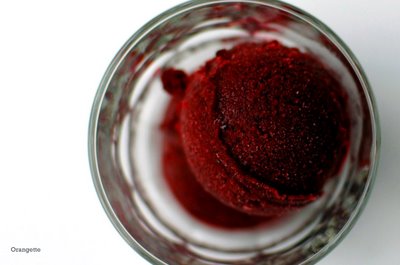A reconciliation, with sorbet
As a kid, I was no fan of summer. I grew up in Oklahoma, where the season is “hotter than h-e-l-l,” as my grandmother likes to say. For me, summer was a sort of sustained misery. The problem was the temperature, plain and simple, which hovers most days in the upper double digits or even lower triples. It’s a still, airless type of heat, the kind that comes with a loud, unceasing soundtrack of cicadas. I used to feel sorry for even the family car, sitting as it did out in the sun: it shimmered under a haze of heat, and when we tried to start it, the poor thing would sputter and whine in protest. Not even a machine should be made to move in such heat. And if you tried to escape it by, say, going into a store or movie theater or someone’s house, the relief only lasted a minute or two, until your teeth started chattering uncontrollably. In most places, the air conditioning was so cold that it required—quite paradoxically—keeping a sweater on hand at all times, just in case. One word, people: h-e-l-l.
But then along came Seattle, with its (mainly) 70-degree summers and its warm—not scorching!—sun. Here, you can survive without air conditioning, and you can eat dinner outside without dying on the spot. This is a city that knows how it’s done. With each passing year, I find myself settling ever deeper into the happy, trusting, summer stupor familiar to dwellers of such climates, knowing that the season will be kind and gentle and that any errant heat waves will be short and only moderately sweaty. Yesterday, as we puttered around the city with our windows down, I actually heard myself say to Brandon, “I just love summer!” I am a changed woman, Seattle.
And it’s not strictly because of matters thermometric: there’s a whole wealth of side benefits too, mainly gastronomical. There’s something about summer in a clement zone, a city where the outdoors and in share the same, easy climate, that inspires in me a likewise easy sensibility about the stuff on my plate. Summer begs for unfussy food, of course, but it also gives it, hand over fist. No other season makes it so easy to eat so well. In the past week, we’ve spent only an hour or two in the kitchen, because, by god, we can. There’s been cold carrot soup, a few salads, and an entire weekend of corn and tomatoes and fresh cheese, repeating like a chorus. I love summer.
And then there are the blackberries in the backyard, which hang from the branches like a few hundred fat cicadas, only quieter. It’s a regular glut out there, the kind of scene that would make any responsible person feel a little panicked, summery stupor or no. So a few evenings ago, in the spirit of the season, we gave the blackberry bush a good, athletic picking, and then we did something really easy: we made sorbet.

With a dark, velvety hue somewhere between burgundy and purple, this sorbet straddles the fence, flavor-wise, between wine and fruit. In fact, it contains both, but the former is just a hint: a sophisticated, suggestive finish to a mouthful of mostly unmessed-with berries. It’s the way I like my summers. It’s h-e-a-v-e-n.
Blackberry Bonny Doon Sorbet
We used Bonny Doon’s delicious “Framboise” dessert wine for this, but you could certainly play with using other types, or even a good crème de cassis. Framboise is made from raspberries—hence its name, en français—and has wonderfully intense, rich, sweet-tart flavor. It doesn’t come through forcefully in the sorbet, but if you look for it, it’s there. Also, the presence of a bit of alcohol helps to keep the sorbet from getting rock-hard in the freezer, which is always a bonus in my book. You never know when you’ll need a spoonful straight from the container.
2 lbs fresh blackberries, washed but not thoroughly dried
4 Tbs light corn syrup*, plus more to taste
¾ cup granulated sugar
¼ cup water
¼ cup Bonny Doon Framboise dessert wine
Place half of the berries in the bowl of a food processor, and purée until very smooth. Remove the puréed berries to a bowl, and repeat with the remaining berries. Set aside.
In a small saucepan, combine the corn syrup, sugar, water, and ½ cup of the berry purée. Place the pan over medium heat, and warm the mixture, stirring, until the sugar is dissolved. Raise the heat to medium high, and boil the mixture for 1 minute. Remove from the heat, and let cool for ten or so minutes.
Add the sugar mixture to the berry purée, and stir until smooth. Add ¼ cup dessert wine, and stir to incorporate. Using a fine-mesh sieve, strain the mixture to remove any lumps and seeds; you may need to use a rubber spatula or spoon to gently push the purée through the sieve. Rinse the sieve well; then strain the purée again. This helps to ensure a very smooth texture. Taste the finished purée: it should be slightly sweeter than you want it to be. (Once it is frozen, it will taste less sweet.) If needed, add more corn syrup a teaspoon at a time, stirring well with each addition. [We added about a tablespoon, but this will vary according to the sweetness of your berries.]
Place the purée in the refrigerator until thoroughly chilled, and then freeze it in an ice cream maker according to the manufacturer’s instructions.
Yield: 1 generous quart
* There is a lot of controversy these days about corn syrup, but I choose to include it in some ice creams and sorbets because it helps to ensure a smooth, less icy texture.

